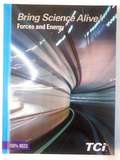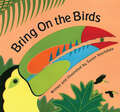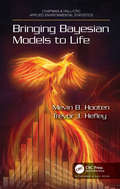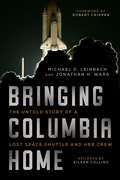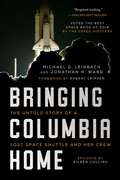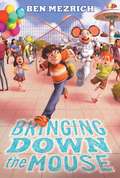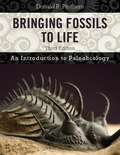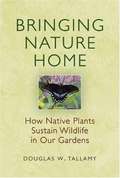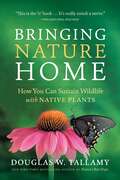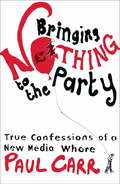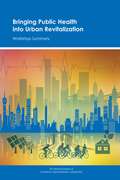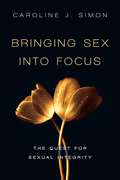- Table View
- List View
Bring Science Alive! Ecosystems
by Teachers’ Curriculum Institute Andrew DakhilNIMAC-sourced textbook
Bring Science Alive! Exploring Science Practices [Grade 3]
by Teachers' Curriculum InstituteNIMAC-sourced textbook
Bring Science Alive! Exploring Science Practices [Grade 4]
by Teachers' Curriculum InstituteNIMAC-sourced textbook
Bring Science Alive! Forces and Energy (History Alive! Series)
by Teachers’ Curriculum Institute Andrew DakhilNIMAC-sourced textbook
Bring Science Alive! Grade 3, Unit 1: Environments and Living Things, Science Journal
by Teachers’ Curriculum InstituteNIMAC-sourced textbook
Bring Science Alive! Grade 3, Unit 2: Forces and Motion, Science Journal
by Teachers’ Curriculum InstituteNIMAC-sourced textbook
Bring Science Alive! Grade 3, Unit 4: Life Cycles and Traits, Science Journal
by Teachers’ Curriculum InstituteNIMAC-sourced textbook
Bring Science Alive! Integrated Notebook: Your Science Investigating Journal Notebook 2
by Teachers’ Curriculum InstituteNIMAC-sourced textbook <p>6th Grade
Bring Science Alive! Planet Earth
by Teachers' Curriculum InstituteBring Science Alive! Planet Earth
Bring Science Alive! Planet Earth (History Alive! Series)
by Teachers’ Curriculum Institute Andrew DakhilNIMAC-sourced textbook
Bring on the Birds
by Susan StockdaleBrightly colored, richly textured illustrations and an energetic rhyming text introduce young readers to birds and their unique qualities. Birds come in all sorts of interesting shapes, sizes, and colors—and many of them can do amazing things as well. From the Blue-footed Booby to the Red-billed Oxpecker, the breadth of bird life depicted in this stunning book will captivate young ornithologists. Susan Stockdale's bold colors and crisp, clean lines capture the reader's attention and introduce us to a remarkable world filled with distinctive creatures. An afterword identifies each animal and tells a little bit about it and where it lives.
Bringing Back the Beaver: The Story of One Man's Quest to Rewild Britain's Waterways
by Derek GowA bold new voice in nature writing, from the front lines of Britain's rewilding movement Bringing Back the Beaver is farmer-turned-ecologist Derek Gow’s inspirational and often riotously funny firsthand account of how the movement to rewild the British landscape with beavers has become the single most dramatic and subversive nature conservation act of the modern era. Since the early 1990s – in the face of outright opposition from government, landowning elites and even some conservation professionals – Gow has imported, quarantined and assisted the reestablishment of beavers in waterways across England and Scotland. In addition to detailing the ups and downs of rewilding beavers, Bringing Back the Beaver makes a passionate case as to why the return of one of nature’s great problem solvers will be critical as part of a sustainable fix for flooding and future drought, whilst ensuring the creation of essential lifescapes that enable the broadest possible spectrum of Britain’s wildlife to thrive.
Bringing Back the Woolly Mammoth: The Great Debate (Fountas & Pinnell Classroom, Guided Reading Grade 5)
by Tina KafkaTURNING BACK TIME The woolly mammoth, with its long curved tusks and shaggy coat, became extinct thousands of years ago. Now some scientists want to turn back time and bring the woolly mammoth back to life, but others are strongly opposed. NIMAC-sourced textbook
Bringing Bayesian Models to Life (Chapman & Hall/CRC Applied Environmental Statistics)
by Mevin B. Hooten Trevor J. HefleyBringing Bayesian Models to Life empowers the reader to extend, enhance, and implement statistical models for ecological and environmental data analysis. We open the black box and show the reader how to connect modern statistical models to computer algorithms. These algorithms allow the user to fit models that answer their scientific questions without needing to rely on automated Bayesian software. We show how to handcraft statistical models that are useful in ecological and environmental science including: linear and generalized linear models, spatial and time series models, occupancy and capture-recapture models, animal movement models, spatio-temporal models, and integrated population-models. Features: R code implementing algorithms to fit Bayesian models using real and simulated data examples. A comprehensive review of statistical models commonly used in ecological and environmental science. Overview of Bayesian computational methods such as importance sampling, MCMC, and HMC. Derivations of the necessary components to construct statistical algorithms from scratch. Bringing Bayesian Models to Life contains a comprehensive treatment of models and associated algorithms for fitting the models to data. We provide detailed and annotated R code in each chapter and apply it to fit each model we present to either real or simulated data for instructional purposes. Our code shows how to create every result and figure in the book so that readers can use and modify it for their own analyses. We provide all code and data in an organized set of directories available at the authors' websites.
Bringing Columbia Home: The Untold Story of a Lost Space Shuttle and Her Crew
by Michael Leinbach Jonathan Ward Eileen Collins Robert CrippenFor the first time, here is the definitive inside story of the Columbia disaster and recovery and the inspiring message it ultimately holds. <P><P>In the aftermath of tragedy, people and communities came together to help bring home the remains of the crew and nearly 40 percent of shuttle, an effort that was instrumental in piecing together what happened so the shuttle program could return to flight and complete the International Space Station. <P><P>Bringing Columbia Home shares the deeply personal stories that emerged as NASA employees looked for lost colleagues and searchers overcame immense physical, logistical, and emotional challenges and worked together to accomplish the impossible. <P><P> Featuring a foreword and epilogue by astronauts Robert Crippen and Eileen Collins, and dedicated to the astronauts and recovery search persons who lost their lives, this is an incredible, compelling narrative about the best of humanity in the darkest of times and about how a failure at the pinnacle of human achievement became a story of cooperation and hope.
Bringing Columbia Home: The Untold Story of a Lost Space Shuttle and Her Crew
by Jonathan H. Ward Eileen Collins Robert Crippen Michael D. LeinbachTimed to release for the 15th Anniversary of the Columbia space shuttle disaster, this is the epic true story of one of the most dramatic, unforgettable adventures of our time.On February 1, 2003, Columbia disintegrated on reentry before the nation’s eyes, and all seven astronauts aboard were lost. Author Mike Leinbach, Launch Director of the space shuttle program at NASA’s John F. Kennedy Space Center was a key leader in the search and recovery effort as NASA, FEMA, the FBI, the US Forest Service, and dozens more federal, state, and local agencies combed an area of rural east Texas the size of Rhode Island for every piece of the shuttle and her crew they could find. Assisted by hundreds of volunteers, it would become the largest ground search operation in US history. This comprehensive account is told in four parts: Parallel Confusion Courage, Compassion, and Commitment Picking Up the Pieces A Bittersweet VictoryFor the first time, here is the definitive inside story of the Columbia disaster and recovery and the inspiring message it ultimately holds. In the aftermath of tragedy, people and communities came together to help bring home the remains of the crew and nearly 40 percent of shuttle, an effort that was instrumental in piecing together what happened so the shuttle program could return to flight and complete the International Space Station. Bringing Columbia Home shares the deeply personal stories that emerged as NASA employees looked for lost colleagues and searchers overcame immense physical, logistical, and emotional challenges and worked together to accomplish the impossible.Featuring a foreword and epilogue by astronauts Robert Crippen and Eileen Collins, and dedicated to the astronauts and recovery search persons who lost their lives, this is an incredible, compelling narrative about the best of humanity in the darkest of times and about how a failure at the pinnacle of human achievement became a story of cooperation and hope.
Bringing Down the Mouse
by Ben MezrichCharlie Lewis goes on a roller coaster ride of risk, math, and gaming in this middle grade novel that parallels the New York Times bestselling Bringing Down the House, which inspired the movie 21 with Kevin Spacey.Charlie Lewis is a nerd. All he's ever been good at is math--and he's really good at math. So good that he's recruited by a group of kids determined to game the system at the biggest theme park in the world--and win the grand prize. Soon Charlie is caught up in the excitement and thrill of using his math skills for awesomeness...but what's at stake may be more than he's willing to risk. How far will Charlie go for a chance at the ultimate reward?
Bringing Fossils to Life: An Introduction to Paleobiology
by Donald R. ProtheroOne of the leading textbooks in its field, Bringing Fossils to Life applies paleobiological principles to the fossil record while detailing the evolutionary history of major plant and animal phyla. It incorporates current research from biology, ecology, and population genetics, bridging the gap between purely theoretical paleobiological textbooks and those that describe only invertebrate paleobiology and that emphasize cataloguing live organisms instead of dead objects. For this third edition Donald R. Prothero has revised the art and research throughout, expanding the coverage of invertebrates and adding a discussion of new methodologies and a chapter on the origin and early evolution of life.
Bringing Nature Home: How Native Plants Sustain Wildlife In Our Gardens
by Douglas W. TallamyBy growing native plants, suburban gardeners can play an important role in helping create sustainable ecosystems. Believing that knowledge will generate interest in being part of the solution, Tallamy (entomology and wildlife ecology, U. of Delaware in Newark) explains why biodiversity is crucial and what to plant to encourage beneficial insects. The gently persuasive book includes color photos; a listing of landscape-worthy, wildlife-attracting native plants by U. S. region; summary table of host plants of butterflies and showy moths; and experimental evidence for the ability of native as vs. alien plants to attract beneficial insects. Annotation ©2008 Book News, Inc. , Portland, OR (booknews. com)
Bringing Nature Home: How You Can Sustain Wildlife With Native Plants
by Douglas W. TallamyThe pressures on wildlife populations today are greater than they have ever been and many gardeners assume they can remedy this situation by simply planting a variety of flowering perennials, trees, and shrubs. As Douglas Tallamy points out in this revelatory book, that assumption is largely mistaken. Wild creatures exist in a complex web of interrelationships, and often require different kinds of food at different stages of their development. There is an unbreakable link between native plant species and native wildlife. When native plant species disappear, the insects disappear, thus impoverishing the food source for birds and other animals. Fortunately, there is still time to reverse this alarming trend, and gardeners have the power to make a significant contribution toward sustainable biodiversity. By favoring native plants, gardeners can provide a welcoming environment for wildlife of all kinds. Healthy local ecosystems are not only beautiful and fascinating, they are also essential to human well-being. By heeding Douglas Tallamy's eloquent arguments and acting upon his recommendations, gardeners everywhere can make a difference.
Bringing Nature Home: How You Can Sustain Wildlife with Native Plants, Updated and Expanded
by Douglas W. Tallamy Rick Darke“If you cut down the goldenrod, the wild black cherry, the milkweed and other natives, you eliminate the larvae, and starve the birds. This simple revelation about the food web—and it is an intricate web, not a chain—is the driving force in Bringing Nature Home.” —The New York Times As development and subsequent habitat destruction accelerate, there are increasing pressures on wildlife populations. But there is an important and simple step toward reversing this alarming trend: Everyone with access to a patch of earth can make a significant contribution toward sustaining biodiversity. There is an unbreakable link between native plant species and native wildlife—native insects cannot, or will not, eat alien plants. When native plants disappear, the insects disappear, impoverishing the food source for birds and other animals. In many parts of the world, habitat destruction has been so extensive that local wildlife is in crisis and may be headed toward extinction.Bringing Nature Home has sparked a national conversation about the link between healthy local ecosystems and human well-being, and the new paperback edition—with an expanded resource section and updated photos—will help broaden the movement. By acting on Douglas Tallamy's practical recommendations, everyone can make a difference.
Bringing Nothing to the Party: True Confessions Of A New Media Whore
by Paul CarrA fascinating and hilarious expose of how a group of young opportunists, chancers and geniuses found instant fame and fortune by messing about on the web. And one man's attempt to follow in their footsteps.Having covered the first dot com boom, and founded a web-to-print publishing business during the second one, Paul counts many of the leading Internet entrepreneurs amongst his closest friends. These friendships mean he doesn't just attend their product launches and press conferences and speak at their events, but also gets invited to their ultra-exclusive networking events, and gets drunk at their parties.Paul has enjoyed this bizarre world of excess without having to live in it. To help the moguls celebrate raising millions of pounds of funding without having to face the wrath of the venture capitalists himself. But in 2006, Paul decided he didn't want to be a spectator any more. He had been harbouring a great dot com project of his own and decided it was time to do something about it.
Bringing Nothing to the Party: True Confessions Of A New Media Whore
by Paul CarrA fascinating and hilarious expose of how a group of young opportunists, chancers and geniuses found instant fame and fortune by messing about on the web. And one man's attempt to follow in their footsteps.Having covered the first dot com boom, and founded a web-to-print publishing business during the second one, Paul counts many of the leading Internet entrepreneurs amongst his closest friends. These friendships mean he doesn't just attend their product launches and press conferences and speak at their events, but also gets invited to their ultra-exclusive networking events, and gets drunk at their parties.Paul has enjoyed this bizarre world of excess without having to live in it. To help the moguls celebrate raising millions of pounds of funding without having to face the wrath of the venture capitalists himself. But in 2006, Paul decided he didn't want to be a spectator any more. He had been harbouring a great dot com project of his own and decided it was time to do something about it.
Bringing Public Health into Urban Revitalization: Workshop Summary
by Robert PoolA particularly valuable opportunity to improve public health arises when an urban area is being redesigned and rebuilt following some type of serious disruption, whether it is caused by a sudden physical event, such as a hurricane or earthquake, or steady economic and social decline that may have occurred over decades. On November 10, 2014, the Institute of Medicine's Roundtable on Environmental Health Sciences, Research, and Medicine held a workshop concerning the ways in which the urban environment, conceived broadly from factors such as air quality and walkability to factors such as access to fresh foods and social support systems, can affect health. Participants explored the various opportunities to reimagine the built environment in a city and to increase the role of health promotion and protection during the process of urban revitalization. Bringing Public Health into Urban Revitalization summarizes the presentations and discussions from this workshop.
Bringing Sex Into Focus: The Quest For Sexual Integrity
by Caroline J. SimonIn a culture that includes sex in everything from advertising to climbing the corporate ladder, it's easy to feel fuzzy about the true purpose and place of sexuality. In this book philosopher and ethicist Caroline J. Simon identifies six "lenses" through which people understand sex and sexuality: covenantal, procreative, expressive, romantic, power and "plain sex. " Guided by a virtue ethic, she applies those lenses to a variety of sexual scenarios, from flirtation and desire to marital sexuality, helping us to see what filters we run issues of sexuality through and how, properly ordered and weighted, they can help us achieve sexual integrity. Here is a book for anyone interested in developing a holistic, biblical sexual ethic that brings into focus the bewildering array of cultural sexual presentations we're surrounded by every day.

